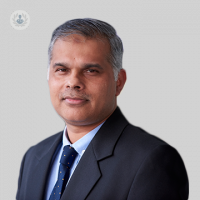All you need to know about aortic valve surgery
Escrito por:Aortic valve surgery is a type of open-heart surgery used to treat problems associated with the aortic valve. The aortic valve may need to be replaced if it becomes narrowed (aortic stenosis) or if the valve is leaky (aortic valve regurgitation).
Mr Shahzad Raja, renowned cardiac surgeon, explains how dangerous aortic valve surgery is, how it’s performed and how open surgery is carried out to replace the faulty or damaged valve.

How dangerous is aortic valve surgery?
Aortic valve replacement is a big operation, and like any other operation, it carries significant risks and has its complications. However, in modern-day clinical practice, aortic valve replacement surgery is a safe operation. The risk of mortality is between 1-3%, and is mainly influenced by the age of the patient.
Other risks include: risk of stroke, acute kidney injury, irregular heartbeat, the need for a pacemaker in less than 1% of patients, and wound and valve infection.
When is aortic valve replacement necessary?
It is necessary to replace the aortic valve when, either the opening of the valve becomes narrow (aortic stenosis) obstructing the flow of blood out of the heart, or if the valve is leaky (aortic valve regurgitation) causing blood to flow back into the heart.
As aortic valve problems are mechanical problems, there is no medicine to treat these problems, therefore, surgery is the best available option.
How is aortic valve replacement surgery done?
Aortic valve replacement surgery is carried out under general anaesthetic. The operation is performed through a large cut made in the centre of the chest, to split the breastbone. The heart is connected to a heart-lung machine to stop the heart from beating, so the operation can be performed in a motionless and bloodless field.
Once the heart has been stopped, the faulty valve is cut out and the new valve is stitched into place. Once the operation is complete, the heart is restarted and the heart-lung machine is removed.
In recent years, minimally invasive procedures have been developed, which include making a cut between the ribs on the right side or splitting just the top half of the breastbone. These approaches are termed as the right mini-thoracotomy approach and the upper midline sternotomy approach.
Can you repair an aortic valve without open-heart surgery?
Yes, you can. There’s an alternative to open-heart surgery called transcatheter aortic valve implantation (TAVI). In this procedure, the replacement valve is inserted using a catheter (hollow tube with a balloon at its tip) into one of the large arteries (femoral or subclavian arteries) and positioned within the damaged valve without having the chest opened.
What are the different types of valves used in aortic valve surgery?
There are two main types of valves, the first is a mechanical valve (metal valve) and the second is a tissue or biological valve, which is usually taken from pigs or cows and in some cases human donors.
Metal valves are usually offered to younger patients to avoid repeat surgery, as these valves are durable and can last a lifetime. However, patients with mechanical valves require life-long anticoagulation (blood thinning medication), which has its downsides. The most common downside is the risk of excessive bleeding if too much blood-thinning medication is taken or the formation of blood clots on the valve if too little blood-thinning medication is taken.
Tissue valves are generally offered to patients who are older than the age of 60, as these valves usually last for 15 years or so. The most important advantage of these valves is that the patient doesn’t require blood thinners. However, patients may require at least one or possibly two further surgeries during their lifetime, as these valves degenerate after 10 to 15 years.
Is aortic valve replacement in the elderly more dangerous?
Aortic valve replacement is not dangerous for all elderly patients, however, if the patient has significant risk factors like poor kidney function or increased furring of the arteries in the neck which can increase the risk of stroke or poor lung function, then they are at higher risk of significant complications and a much greater risk of dying from the procedure. Hence, for these patients, TAVI is emerging as a useful alternative.
Would you like to know more about aortic valve surgery? Why not schedule a consultation with Mr Shahzad Raja.


